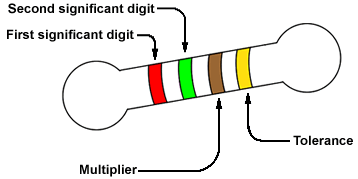Day to day advancement in technologies is creating better life
one of the wonder of advanced technology is SMD's→surface mount devices
in smd's the size of device is very small compared to its original one
IN NORMAL RESISTORS we use color coding for identification of its resistance

click on this link to get resistor calculator
but in smd's
How to calculate the value of an SMD resistor
Most chip resistors are marked with a 3-digit or 4-digit code
NOTE:
- an SMD resistor with a marking of 0, 00, 000 or 0000 is a jumper (a zero-ohm link).
The 3-digit code
Standard-tolerance SMD resistors are marked with a simple 3-digit code. The first two numbers will indicate the significant digits, and the third will be the multiplier, telling you the power of ten to which the two significant digits must be multiplied (or how many zeros to add). Resistances of less than 10 ohms do not have a multiplier, the letter 'R' is used instead to indicate the position of the decimal point.
3-digit code examples:
220 = 22 × 100 (1) = 22Ω (not 220Ω!)
471 = 47 × 101 (10) = 470Ω
102 = 10 × 102 (100) = 1000Ω or 1kΩ
3R3 = 3.3Ω
471 = 47 × 101 (10) = 470Ω
102 = 10 × 102 (100) = 1000Ω or 1kΩ
3R3 = 3.3Ω
The 4-digit code
The 4-digit code is used for marking precision surface mount resistors. It's similar to the previous system, the only difference is the number of significant digits: the first three numbers will tell us the significant digits, and the fourth will be the multiplier, indicating the power of ten to which the three significant digits must be multiplied (or how many zeros to add). Resistances of less than 100 ohms are marked with the help of the letter 'R', indicating the position of the decimal point.
4-digit code examples:
4700 = 470 × 100 (1) = 470Ω (not 4700Ω!)
2001 = 200 × 101 (10) = 2000Ω or 2kΩ
1002 = 100 × 102 (100) = 10000Ω or 10kΩ
15R0 = 15.0Ω
click on this link for smd calcualtor
This the end of the post
2001 = 200 × 101 (10) = 2000Ω or 2kΩ
1002 = 100 × 102 (100) = 10000Ω or 10kΩ
15R0 = 15.0Ω
click on this link for smd calcualtor
This the end of the post



No comments:
Post a Comment